Vagrant Species Part 2
Issue date: 9th November 2020
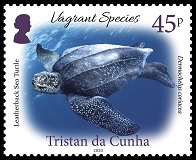 |
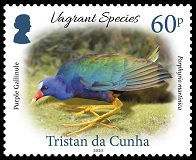 |
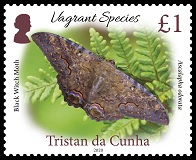 |
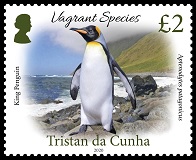 |
| 202011 | Mint Stamps (45p, 60p, £1.00, £2.00) | £4.05 |
| 202012 | First Day Cover (with 45p, 60p, £1.00, £2.00 stamps) | £5.05 |
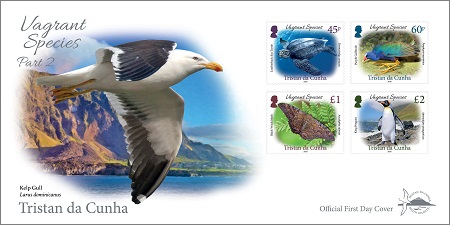
Tristan da Cunha lies in the middle of the South Atlantic Ocean, east of the mid-Atlantic ridge, 2,800km from the continental shores South Africa, and 3,360km from South America. It is the most remote island in the world with a resident human population, with St. Helena, the nearest island some 2,400km away. Vagrant species might seem to be a curiosity, but all of the native animals on Tristan arose from individuals that wandered far from their usual haunts.
45p - Leatherback Turtle (Dermochelys coriacea) is sometimes called the lute turtle or leathery turtle. They are the largest sea turtle species and also one of the most migratory, crossing both the Atlantic and Pacific Oceans. It can easily be differentiated from other modern sea turtles by its lack of a bony shell, hence the name. Instead, its carapace is covered by skin and oily flesh. Numbers of Leatherback Turtles have seriously declined during the last century due to intense egg collection and fisheries bycatch. Globally, the Leatherback Turtle is listed as Vulnerable by the IUCN.
In 2017 a Leatherback Turtle tagged by University of Exeter scientists in Brazil swam thousands of miles into waters off the Tristan da Cunha Islands. The female leatherback turtle, nicknamed Fubica, explored the seas off Tristan Da Cunha. Fubica, one of four turtles tagged on a Brazilian beach during the breeding season in November 2017, was the only one whose tag was still transmitting, more than six months later. The turtles were tagged as part of a study run by Exeter and Brazilian non-profit organisation TAMAR-ICMBio, with funding from Funbio (the Brazilian Fund for Biodiversity).
60p - Purple Gallinule (Porphyrio martinica) occurs throughout the tropics in the Americas. It is a fairly large, slender rail that is fairly closely related to the moorhens that managed to colonise Tristan and Gough. The adults are strikingly coloured, but many of the birds reaching Tristan are much duller juveniles, which are perhaps more likely to get blown off course as they migrate north in autumn from their breeding areas in Uruguay and northern Argentina. They are birds of wetlands and swamps, and their long toes help them walk onto floating vegetation, by distributing their weight. Their diet is varied as they feed on a wide variety of vegetable and animal matter.
Sightings of this bird were quite frequent on Tristan in the second half of the 20th century, with up to 47 in one year, but they have become less common in recent years. Almost all records are from around the settlement Edinburgh of the Seven Seas, where they take shelter in island gardens and surrounding flax. The local name for this bird is ‘Guttersnake’ presumably for is shiny greeny-blue colour and by the way it swiftly moves through the grass.
£1 - Black Witch Moth (Ascalapha odorata) is a large bat-shaped, dark-coloured nocturnal moth, ranging from Brazil to the southern United States. It is the largest noctuid in the continental United States. In the folklore of many Central American cultures, it is associated with death or misfortune. Female moths can attain a wingspan of 17 cm. Their wings are mottled brown with hints of iridescent purple and pink, and, in females, crossed by a white bar.
The Black Witch Moth was also depicted on a 15p stamp in the 1990s stamp issue Moths. In 2018 there was a sighting of the moth during a big storm on the RRS Discovery. It was trying to land on the ship whilst anchored off Inaccessible!
£2 - King Penguin (Aptenodytes patagonicus) is the second largest species of penguin, smaller, but somewhat similar in appearance to the Emperor Penguin. King Penguins breed on sub-Antarctic islands between 45 and 55°S, with a large population on South Georgia. The total population is estimated to be 2.23 million pairs and is increasing. Like its larger cousin, they lay a single egg which they incubate balanced on their feet, and males are able to store food in their stomachs for more than a month, ready to feed the chick when it hatches.
They are prodigious swimmers and divers, regularly diving to 300 m deep and commuting hundreds of kilometres from their colonies to find food for their chick. After breeding, adults disperse vast distances, sometimes venturing well outside their normal range. There was a sighting of a King Penguin on Tristan’s beach over decade ago, but they are somewhat more common as vagrants on Gough Island, which being farther south is closer to their normal haunts.
FDC - Kelp Gull (Larus dominicanus) is the common ‘black-backed’ gull in the Southern Hemisphere, occurring in South America, southern Africa, Madagascar, Australia, New Zealand, most sub-Antarctic islands, and locally in the maritime Antarctic. Tristan is one of the few islands lacking the species. Like most large gulls, they are supreme generalists that eat a wide range of prey, including scavenging from carcasses.
Kelp Gulls, probably from South America, are one of the most regular vagrants to the Tristan archipelago. There are no confirmed breeding records from the islands, but in 1922, George Wilkins recorded an adult Kelp Gull with juvenile birds on Nightingale Island. When asked, the islanders did not think that they bred, but some of the young birds were thought to have been too young to migrate all the way to the island. A young Kelp Gull, was seen and photographed this year on 25th August, on the beach to the west of Calshot Harbour.
Technical Specifications from Pobjoy Mint Ltd.
| Designer: | Andrew Robinson | Stamp size: | 30.6 x 38mm |
| Printer: | Cartor Security Printing | Perforation: | 13¼ x 13 per 2cms |
| Process: | Stochastic Lithography | Layout: | 10 |
| Production Co-ordination: | Creative Direction (Worldwide) Ltd |
